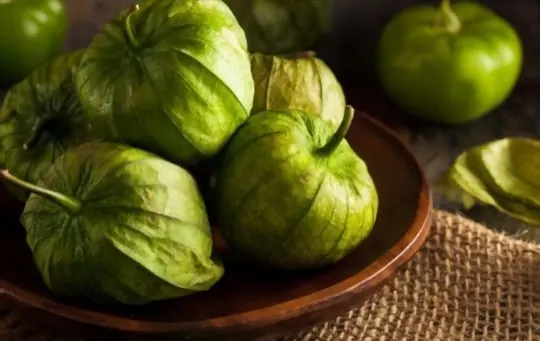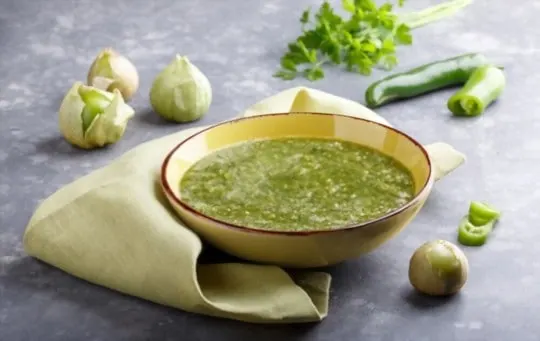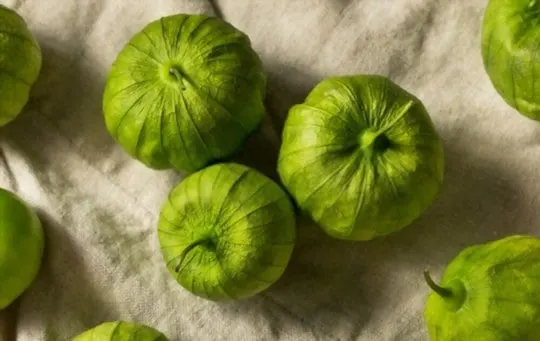Taco, salsa, guacamole.
You probably already love these foods, but have you ever wondered what the key ingredient tastes like on its own?
We’re talking about the tomatillo.
If you’ve never had a tomatillo, you might be wondering what does tomatillo taste like.
The answer is that it depends on many factors like how it’s prepared, what variety it is, and how ripe it is.
Today, we’ll be exploring all things tomatillo so you can better understand what this unique fruit tastes like.
What is Tomatillo?

The tomatillo, Physalis philadelphica, is a plant of the nightshade family.
The plant bears tiny, spherical, and green or purple fruit of the same name.
A member of the physalis genus, the tomatillo is native to Central America and Mexico.
Appearance-wise, the tomatillo looks a bit like a small, unripe tomato encased in a papery husk.
The husk is typically removed before eating or cooking.
There are several varieties of tomatillos, broadly categorized into two groups by color: Green and Purple.
Tomatillos are a key ingredient in salsa verde and many Mexican dishes.
They’re also excellent roasted and served as a side dish or in a salad.
What Do Tomatillos Taste Like?

If you’ve never tasted a tomatillo, you’re in for a treat.
This unique fruit has a tangy, sour flavor that’s often compared to unripe green tomatoes.
While the taste of tomatillos can vary depending on how they’re prepared, most describe the flavor as being slightly acidic with hints of lemon or lime.
Some say the flavor is similar to green bell pepper, while others find it reminiscent of a sour apple.
Tomatillos can be eaten raw or cooked, and their flavor will change depending on how they’re prepared.
When eaten raw, they have a crisp texture and a tart, lemony flavor.
When cooked, their flavor becomes milder and sweeter.
The flavor of tomatillo may also slightly vary depending on its variety.
For example, the most popular variety, the Tomatillo Verde, doesn’t taste as sweet but goes exceptionally well in savory dishes.
Tomatillo Amarylla is another popular type with a sweeter flavor, reminiscent of your everyday tomato, while Tomatillo Purple tends to have a sharper taste than their green counterparts.
- Nutritional Value of Tomatillo.
Not only are tomatillos delicious, but they’re also packed with nutrients.
Tomatillos are an excellent source of vitamins A and C and potassium.
They also contain small amounts of calcium, iron, and magnesium.
Tomatillos are low in calories and fat but super rich in fiber, making them an excellent addition to any healthy diet.
These tiny fruits also contain unique antioxidant phytochemicals linked to anti-cancer properties.
Besides, tomatillos are a rich source of niacin known to boost metabolism and provide a quick burst of energy.
How to Cook and Use Tomatillos?

The tomatillo, also known as the Mexican husk tomato, is a staple ingredient in Mexican and Central American cuisine.
The fruit is small and green, encased in a papery husk.
You can enjoy this small fruit raw or cooked. Raw tomatillos are super versatile.
All you have to do is remove the husk and give them a rinse.
You can then add raw tomatillos to salads, salsas, or soups.
If you want to cook with tomatillos, the options are endless.
You can roast them, fry them, or bake them.
Tomatillos pair well with meats, veggies, and beans.
One of our favorite recipes is roasting tomatillos.
- Just cut them in half and place them on a baking sheet.
- Add some olive oil, garlic, salt, and pepper.
- Roast in the oven at 400° F for 15-20 minutes.
- This recipe is simple and delicious.
Try it out the next time you’re looking for a new way to cook tomatillos.
Another popular way to use tomatillos is in salsa.
Salsa verde, or green salsa, is made with tomatillos, jalapeños, cilantro, and onion.
The ingredients are blended to create a flavorful and refreshing salsa.
Whether you’re looking for a new way to spruce up your salads or just want to try something different, raw tomatillos are a great option.
Give them a try the next time you’re in the kitchen.
Final Thought
Tomatillos originated in Mexico and were cultivated in the pre-Columbian era.
Although tomatillos are available year-round, they’re in peak season from early summer to fall.
So, you guessed it right. Now is the perfect time to start cooking with this savory fruit.
When selecting tomatillos, look for firm ones with tight-fitting husks.
The husks should be dry and slightly yellowed.
Avoid tomatillos with brown spots or those that have started to leak through their husks.
Once you bring your tomatillos home, you can wash them and start cooking immediately.
Or, you can store them in the fridge for later use.
Just be sure to remove the husks before cooking or eating them.

What Do Tomatillos Taste Like? Do Tomatillos Taste Good?
Ingredients
- Tomatillos
- Ingredients from your favorite recipes
Instructions
- Depending on the ingredients used, the cooking method, and the type of dish, the taste of the food can vary greatly.
- Make sure to select a recipe that will elevate the foodu0026#x27;s original flavor, and enjoy experimenting with different recipes!

Andrew Gray is a seasoned food writer and blogger with a wealth of experience in the restaurant and catering industries. With a passion for all things delicious, Andrew has honed his culinary expertise through his work as a personal chef and caterer.
His love for food led him to venture into food writing, where he has contributed to various online publications, sharing his knowledge and insights on the culinary world. As the proud owner of AmericasRestaurant.com, Andrew covers a wide range of topics, including recipes, restaurant reviews, product recommendations, and culinary tips.
Through his website, he aims to inspire and educate fellow food enthusiasts, offering a comprehensive resource for all things food-related.

Leave a comment